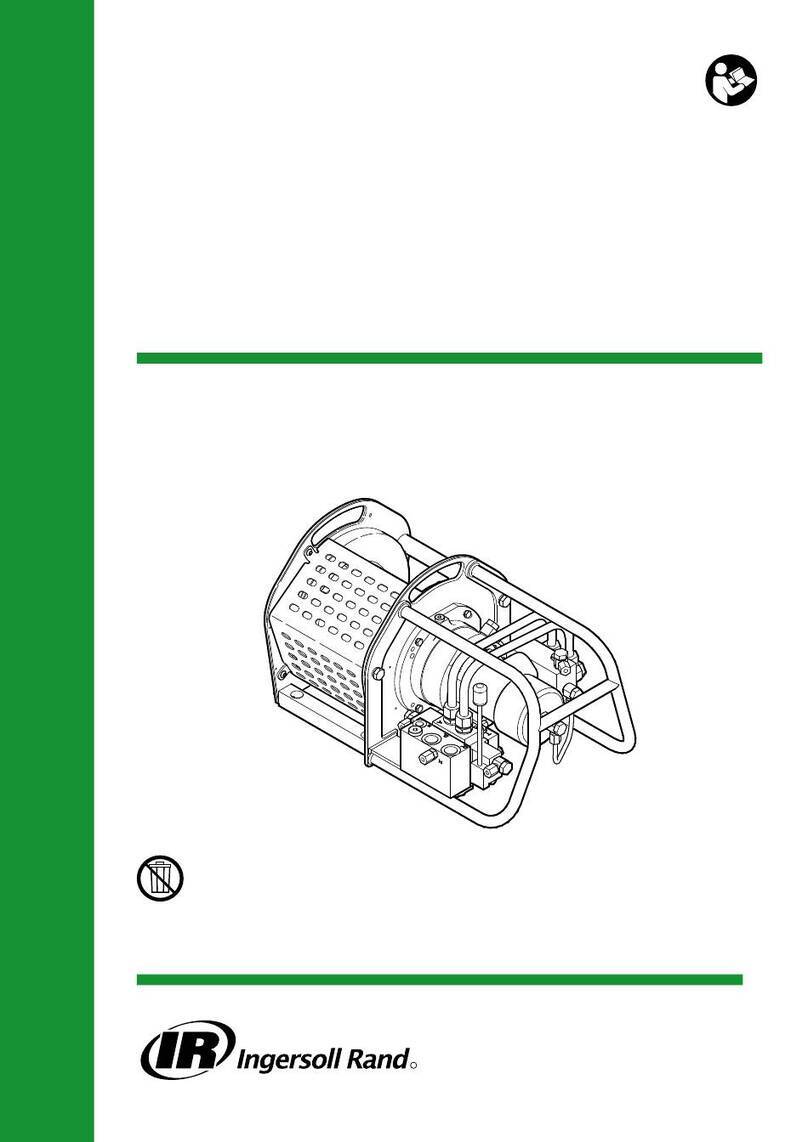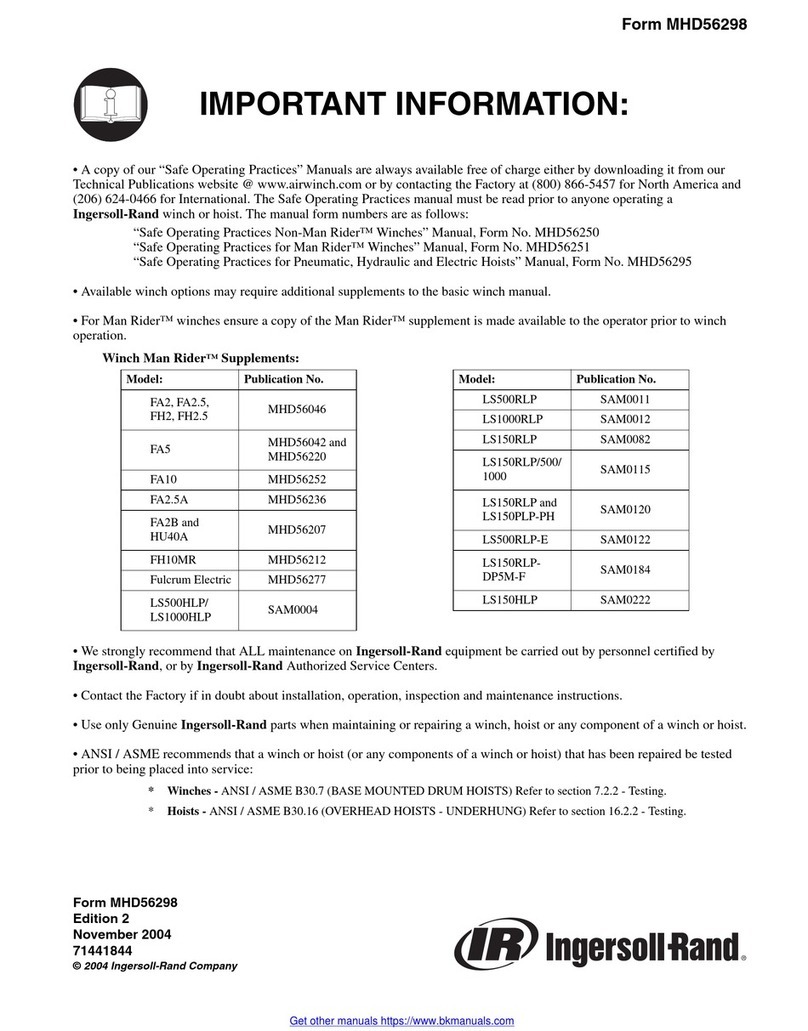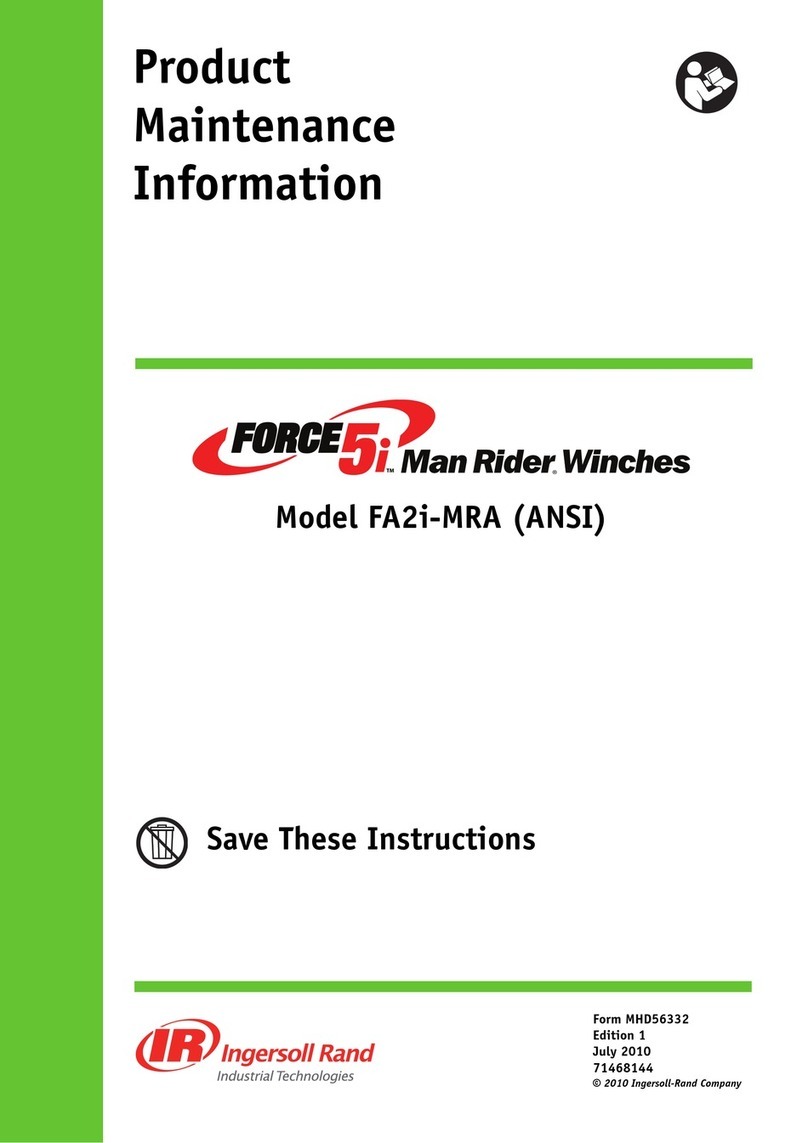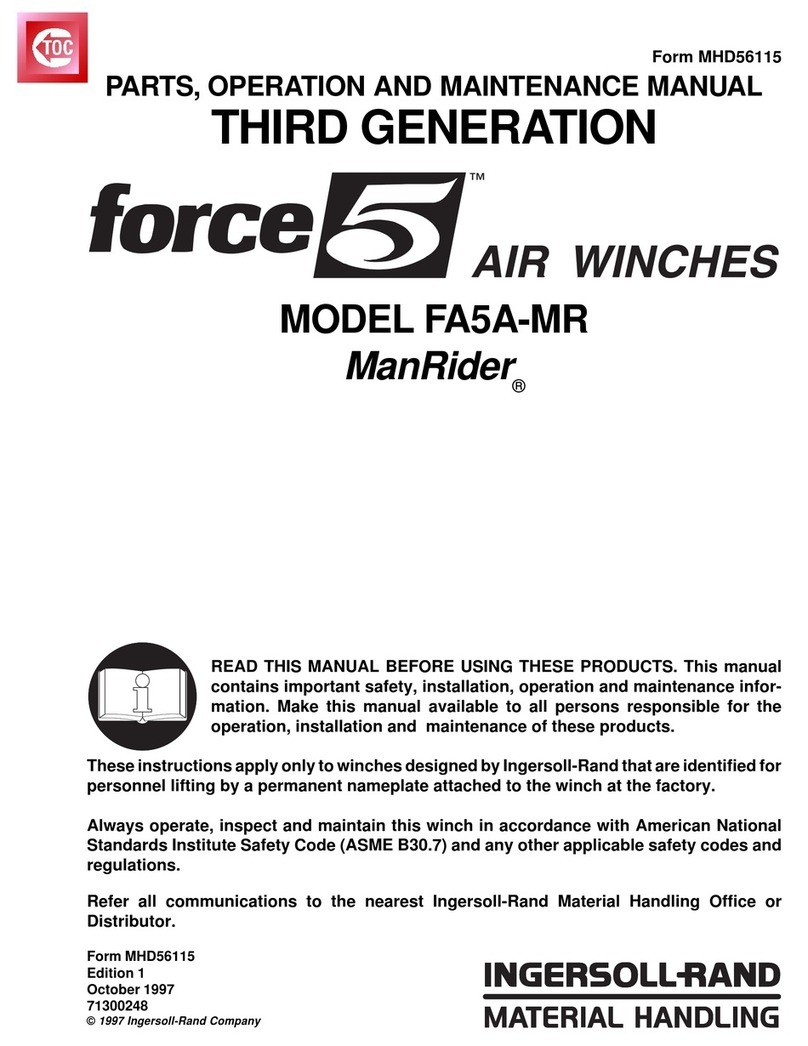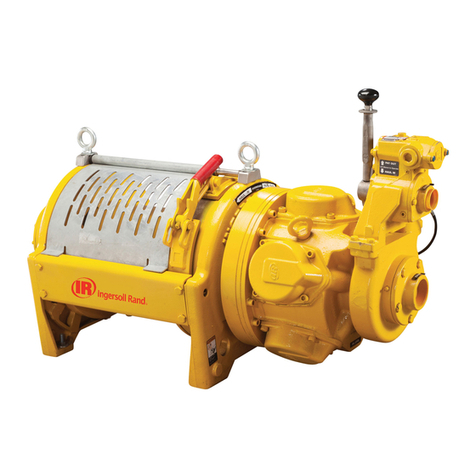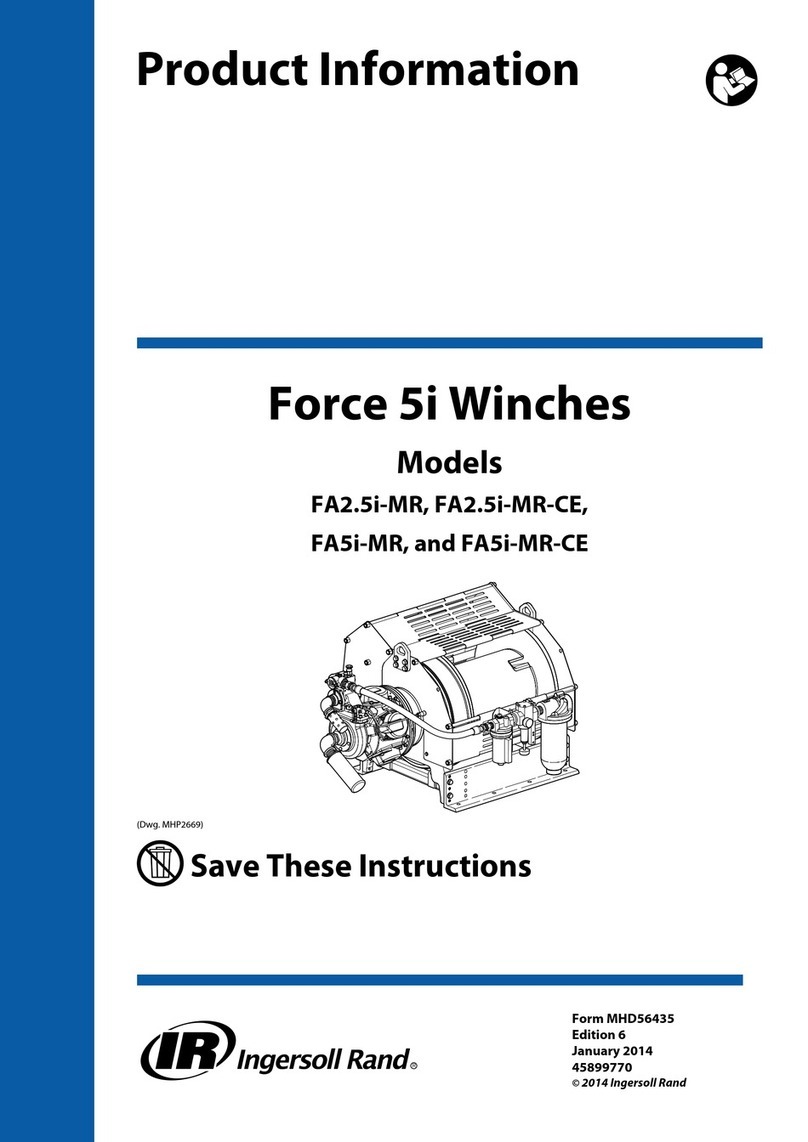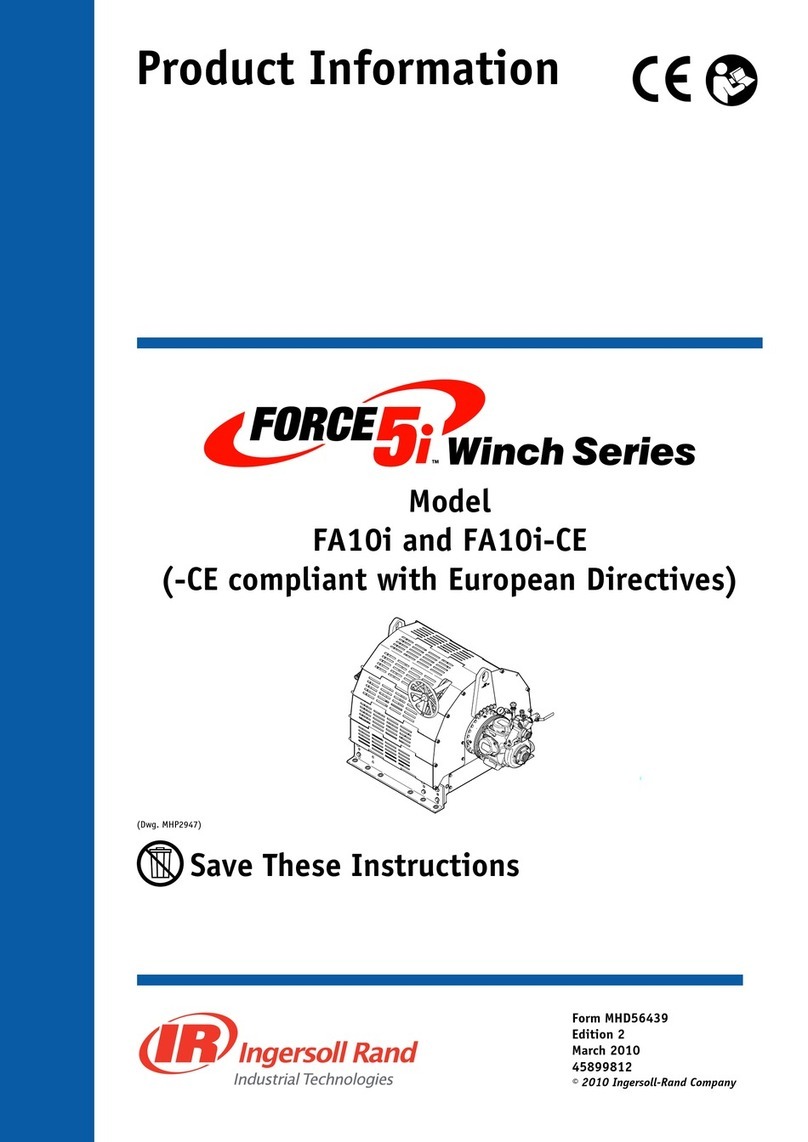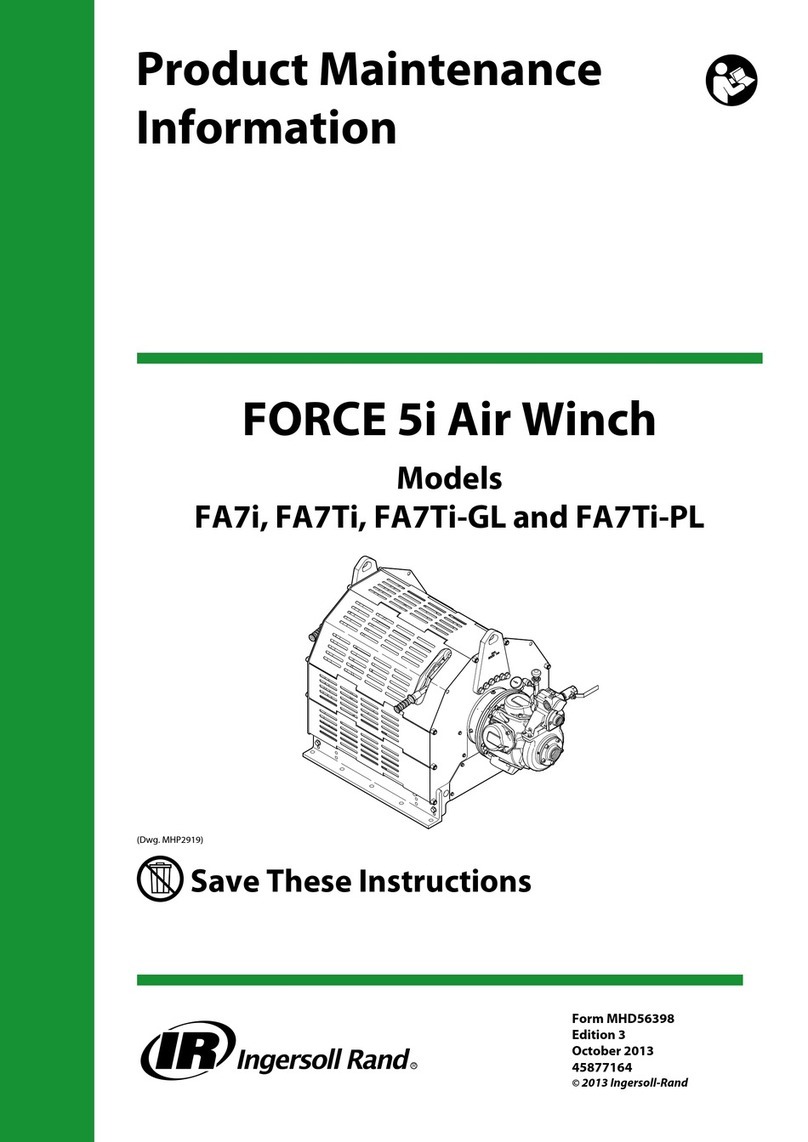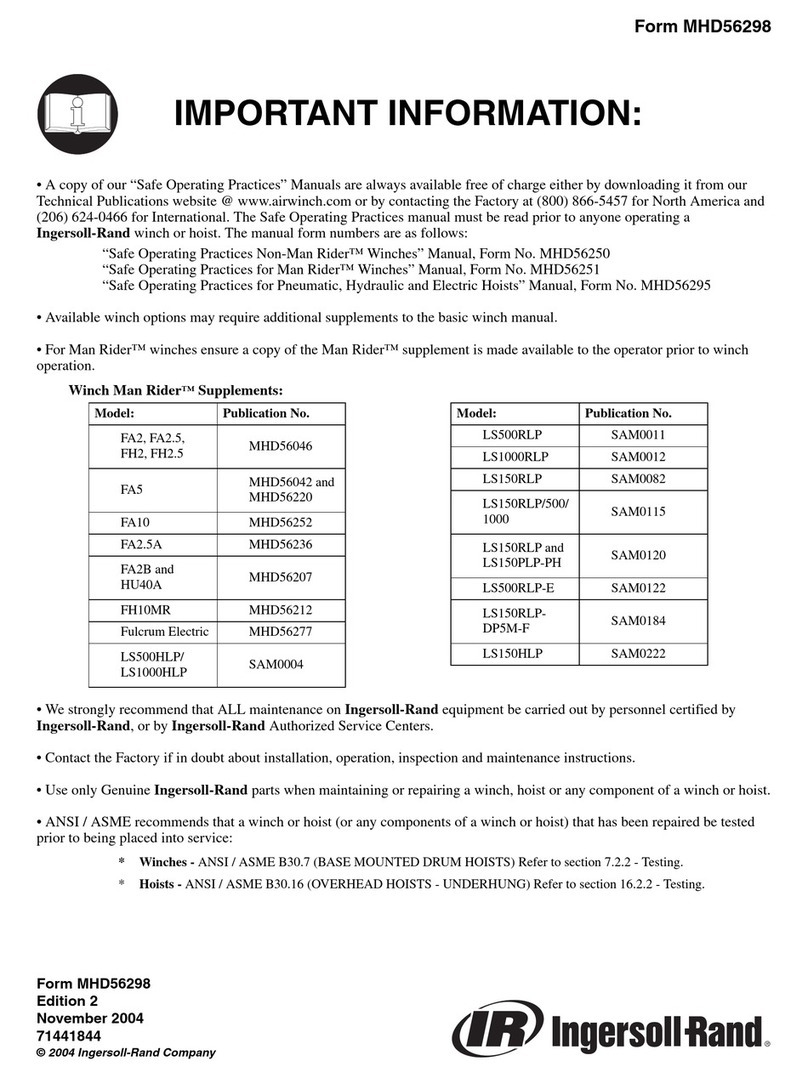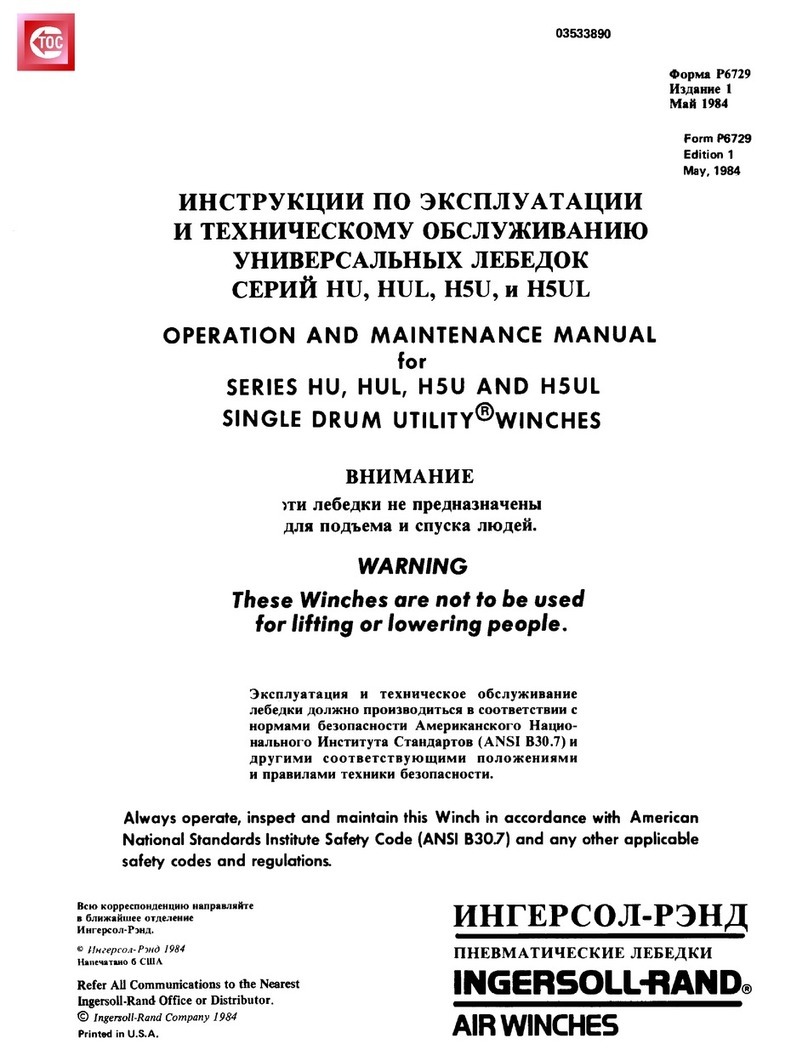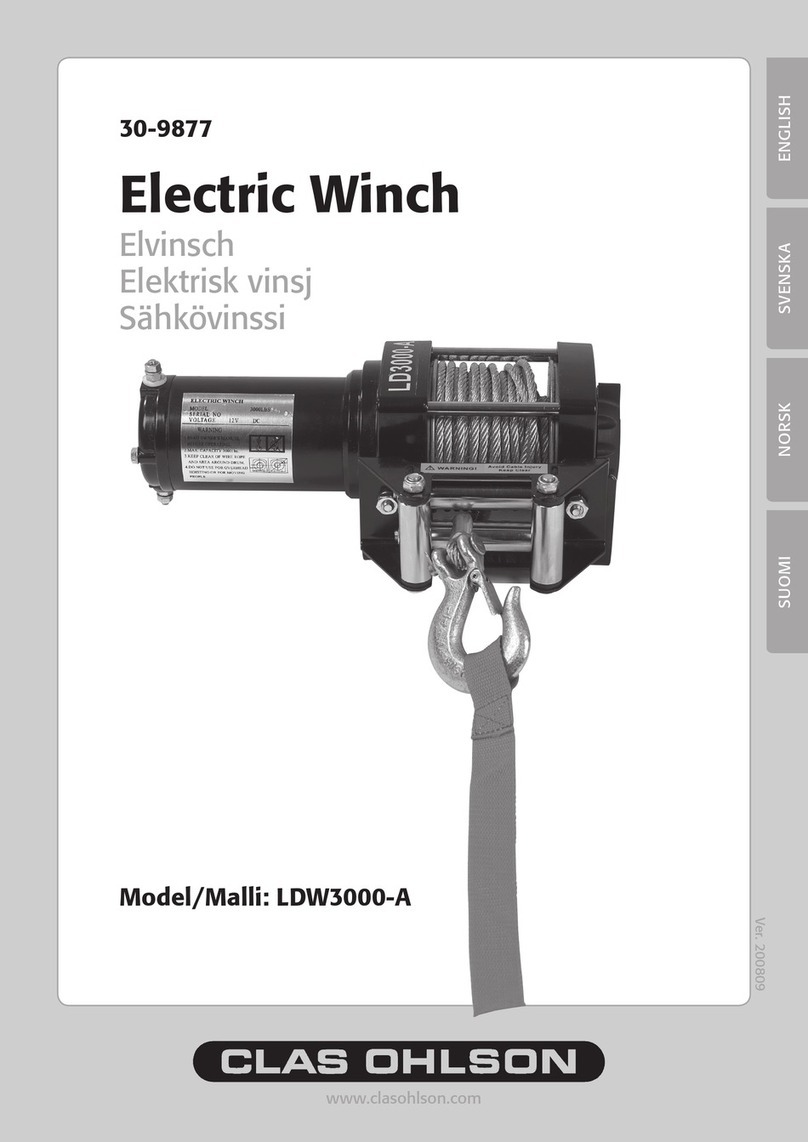
NOTICE
• Ensure press roller assembly is adequately supported before removing
shaft (403).
3. Remove capscrews (408) and washers (409) from both ends of shaft (403), and
carefullyslideshaft (403)throughhole inupright(42). Pressrollerassembly (400)
and collar (404) will fall away from shaft (403).
4. It is not necessary to remove bushings (410) unless replacing
5. Remove springs (405) and (406) from press roller arm (407).
6. Removecapscrews (408),washers(409)androllers(402)from endsof pressroller
arm (407).
nDrum Locking Pin Disassembly
Refer to Dwg. MHP2675.
1. Remove capscrews (305) and washers (306) to separate drum locking pin
assembly from winch upright (84).
2. Unscrew shaft (304) from drum lock pin (312). Separate cover (307), spring (310),
drum lock pin (312) and housing (308) from assembly.
3. Remove nut (303) and capscrew (302) to separate handle (301) from shaft (304).
4. Do not remove bushing (311) from winch upright (84) unless replacement is
required.
nCleaning, Inspection and Repair
nCleaning
Clean all winch component parts in solvent (except drum brake bands). The use of
a stiff bristle brush will facilitate removal of accumulated dirt and sediments in the
reduction assembly, on housings, frame and drum. If bushings have been removed,
it may be necessary to scrape old Loctite® from bushing bores. Dry each part using
low pressure, filtered compressed air. Clean drum brake band using a wire brush or
emery cloth. Do not wash drum brake band in solvent. If drum brake band lining is
oil soaked, it must be replaced.
nInspection
All disassembled parts should be inspected to determine their fitness for continued
use. Pay particular attention to the following:
1. Inspect all gears for worn, cracked or broken teeth.
2. Inspect all bushings for wear, scoring or galling.
3. Inspect shafts for ridges caused by wear. If ridges caused by wear are apparent
on shafts, replace shaft. Inspect all surfaces on which oil seal lips seat.
4. Inspect all bearings for play, distorted races, pitting, and roller or ball wear or
damage. Inspect bearings for freedom of rotation.
5. Inspect all threaded items and replace those having damaged threads.
6. Inspect drum band brake lining for oil, grease and glazing. If drum band brake
lining is oil-soaked, replace brake bands as a set. Remove glazed areas of band
brake lining by sanding lightly with a fine grit emery cloth.
7. Measure thickness of drum band brake lining. If drum brake band linings are less
than 0.062 in. (2 mm) thick anywhere along edges replace brake bands (128) as
a set.
nRepair
Actual repairs are limited to removal of small burrs and other minor surface
imperfections from gears and shafts. Use a fine stone or emery cloth for this work.
Do not use steel wool.
1. Worn or damaged parts must be replaced. Refer to the applicable Parts Listing
for specific replacement parts information.
2. Inspect all remaining parts for evidence of damage. Replace or repair any part
that is in questionable condition. Cost of the part is often minor in comparison
with cost of redoing job.
3. Smooth out all nicks, burrs or galled spots on shafts, bores, pins or bushings.
4. Examine all gear teeth carefully, and remove nicks or burrs.
5. Polishedgesofallshaft shoulderstoremovesmallnicks causedduringhandling.
6. Remove all nicks and burrs caused by lockwashers.
7. Replace all gaskets, oil seals and ‘O’ rings removed during winch disassembly.
nAssembly
nGeneral Assembly Instructions
•Use all new gaskets and seals.
•Replace worn parts.
•Assemblepartsusingmatchmarks attached during disassembly. Compare
replacement parts with originals to identify installation alignments.
•Lubricateallinternalparts with rustandoxidationinhibiting lubricant, ISO
VG 100 (SAE 30W).
•Apply a light coat of Loctite® 243 to all threaded components prior to
assembly.
nDisc Brake Assembly
Ensure disc brake is assembled in accordance with brake manufacturer’s literature.
nMotor Assembly
Ensure motor is assembled in accordance with motor manufacturer’s literature.
nReduction Gear Assembly
NOTICE
• It is important to maintain a clean work area when reduction assemblies
arereassembled.Duringreassemblycleaneachpartthoroughlyandlightly
coatwithappropriate lubricant asdescribedin ‘Recommended Lubricants’
in the “LUBRICATION” section of the Product Information Manual.
Refer to Dwg. MHP2850.
1. Install bearing (49) and retainer ring (50) in gear carrier (47).
2. Lubricate and install ‘O’ rings (51) on ring gear (53).
3. Align capscrew holes and dowel pins with gear carrier (47) and install ring gear
(53). Ensure ‘O’ rings are not damaged during installation.
4. Install planetary assembly (54).
5. Install thrust bearing (55) into sun gear (56).
6. Install retainer ring (57) on sun gear and locate in planetary assembly (54).
7. Align capscrew and dowel holes and install input housing (59). Apply a light
coating of Loctite® 262 to capscrew (60) threads and install by hand. Equally
tighten capscrews in a diametrically opposed pattern to allow for equal
compression of housing onto ring gear (53) and gear carrier (47). When ring gear
and input housing flanges are flush with gear carrier, torque capscrews to 95 ft
lbs (128 Nm).
8. Install dowel pins (52) and tap into position until slightly below input housing
flange.
9. Install planetary assembly (58) onto sun gear (56).
10. Lubricate and install ‘O’ rings (62) on ring gear (63).
11. Install dowel pins (70) in ring gear (63) so they extend an equal distance on both
sides of ring gear.
12. Align capscrew holes and dowel pins and install ring gear (63) on input housing
(59). Using a soft hammer or mallet, carefully tap dowel pins and ring gear (63)
onto input housing until mating flanges are flush. Ensure ‘O’ rings are not
damaged during installation.
13. Place thrust bearing (55) in sun gear (66) and install sun gear into planetary
assembly (58).
14. Install planetary assembly (67) onto sun gear (66).
15. Align capscrew holes and dowel pins and install spacer (71) onto ring gear (63).
Using a soft hammer or mallet, carefully tap spacer onto ring gear until mating
flanges are flush. Ensure ‘O’ rings are not damaged during installation.
16. Lubricate and install ‘O’ rings (62) on ring gear (72).
17. Using a soft hammer or mallet, carefully tap ring gear (72) onto spacer (71).
Ensure ‘O’ rings are not damaged during installation.
18. Install sun gear (69) in planetary assembly (67).
19. Align capscrew and dowel holes and install cover (73). Use a soft hammer or
mallet to carefully tap the cover until flush with ring gear (72). Apply a light
coating of Loctite® 242 to capscrew (75) threads and install by hand. Equally
tighten the capscrews in a diametrically opposed pattern to allow for equal
compression of cover onto ring gear (72) and spacer (71). When cover, ring gear,
and spacer flanges are flush, torque capscrews to 32 ft lbs (42 Nm).
20. Install dowel pins (74) and tap into position until slightly below cover flange.
21. Place a bead of Loctite® 515 sealant on surface that mates with gear carrier.
Sealant location should be inside bolt pattern.
22. Align capscrew and dowel holes and install reduction gear assembly into drum
(80). Apply a light coating of Loctite® 242 to capscrew (45) threads and install
capscrews and lockwashers (46). Torque capscrews to 255 ft lbs (346 Nm).
23. Install two dowel pins (86) and tap into position until slightly below gear carrier
flange.
24. Apply thin coat of Loctite® 609 to outside of seal (43) and, with seal lip facing
out, install in gear carrier (47).
nDrum Assembly
Refer to Dwg. MHP2850.
Refer to “Winch Assembly” for assembly of inboard upright (42) and drum shaft (41).
1. Stand drum (80) in an upright position. Align splines and carefully lower inboard
upright and drum shaft assembly onto drum (80).
2. Using a ‘C’ clamp, secure inboard flange assembly to drum flange and set
complete assembly in a horizontal position.
3. Clean surface, pack bearing (87) with grease and install in outboard upright (84).
4. Install outboard upright (84) on drum end. Ensure assembly is kept centered on
journal during this step.
5. Install bearing retainer (92). Secure by installing two capscrews (94). Lightly coat
capscrew threads with Loctite® 242. Torque to 30 ft lbs (41 Nm).
6. Apply a light coat of Loctite® 515 sealant to mating surface of outboard upright
(84)andinstallend cover (95). Secureusingfourcapscrews (97) and lockwashers
(96). Lightly coat capscrew threads with Loctite® 242. Torque to 30 ft lbs (41 Nm).
7. Install siderails (82) to uprights (42) and (84) and loosely secure using capscrews
(85) and lockwashers (98).
8. Tap dowel pins (86) into position until flush with siderails.
9. Tighten eight capscrews (85) evenly. Torque to 140 ft lbs (190 Nm).
10. If lifting lugs (83) have been removed, attach with capscrews (90) and washers
(98) to upright(s) (42) and (84).
nManual or Automatic Brake Assembly
Refer to Dwg. MHP2852.
1. Install pivot bracket (122) on the end of arm (124) with pin (121) and cotter pin
(102). Recessed side of threaded hole must be toward the band side.
2. Install connecting link (125) on arm (124) and secure in position with pin (121),
washer (98) and cotter pin (102). Assemble connecting link (125) so curved
surface matches contour of brake band.
3. Install halves of brake band (128) to connecting link (125) and secure with pins
(101), (121), washers (98) and cotter pins (102).
4. Lift winch assembly, with a suitable hoist, approximately 6 inches (15 cm) off the
floor or work bench.
5. Position brake band sub-assembly around brake diameter on drum (80) so arm
(124) lays at the bottom. When band is positioned, lower winch.
6. Manual band brake: Mount pivot bracket (122) on inside surface of siderail (82)
and secure in position with capscrews (116) and lockwashers (117).
8 Form MHD56375 Edition 2
